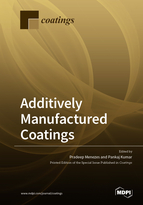Additively Manufactured Coatings
A special issue of Coatings (ISSN 2079-6412). This special issue belongs to the section "Surface Characterization, Deposition and Modification".
Deadline for manuscript submissions: closed (31 December 2020) | Viewed by 18465
Special Issue Editors
Interests: manufacturing; material processing; surface engineering; electrochemical analysis; advanced material structures
Special Issues, Collections and Topics in MDPI journals
Interests: advanced manufacturing; additive manufacturing; alloys and microstructure design; mechanical behavior of materials
Special Issues, Collections and Topics in MDPI journals
Special Issue Information
Dear Colleagues,
Functional coatings are of particular importance to protect the substrate from chemical and mechanical damage in aggressive environments. They are widely used as cost-effective methods to protect the substrate from wear, corrosion, erosion, tribocorrosion, high temperature and high pressure in extreme environmental conditions. These are primarily manufactured through metal/ceramic powder deposition in a subsequent layer by layer fashion on the substrate materials. In all cases, the functional coatings need to be reliable for the intended application. The emerging 3D printing/additive manufacturing techniques can be utilized to develop high-performance functional coatings. These methods provide geometrical precision, flexibility in geometrical complexity, customization of the coating layers, and reduce the raw materials waste, keeping the manufacturing cost low while addressing many of the technical barriers of conventional coating methods. With the rapid development of cutting-edge value-added technologies in aerospace, nuclear, military, space, and energy industry, 3D printing/additive manufacturing techniques will be major advantages. Novel functional coatings and 3D printing/additive manufacturing techniques will be critical to value-added components in the future development of technologies. The scope of this Special Issue covers technologies from solid-state coating methods to direct energy deposition that develops metal, ceramic, and composite coatings. This Special Issue is devoted to recent advances in functional coatings, including but not limited to metal, ceramic, and composite utilizing 3D printing/additive manufacturing techniques. Original research and review articles in relevant topics are welcomed.
Proposed topics of this Special Issue:
Cold spray and supersonic powder deposition techniques
Friction stir additive manufactured processes
Laser and electron beam-based additive manufacturing coating techniques, inkjet methods, and other 3D printing techniques
Case studies of functional coatings using advanced additive manufacturing techniques
Advanced functional coatings, including metallic, ceramics, and composites
Dr. Pradeep Menezes
Dr. Pankaj Kumar
Guest Editors
Manuscript Submission Information
Manuscripts should be submitted online at www.mdpi.com by registering and logging in to this website. Once you are registered, click here to go to the submission form. Manuscripts can be submitted until the deadline. All submissions that pass pre-check are peer-reviewed. Accepted papers will be published continuously in the journal (as soon as accepted) and will be listed together on the special issue website. Research articles, review articles as well as short communications are invited. For planned papers, a title and short abstract (about 100 words) can be sent to the Editorial Office for announcement on this website.
Submitted manuscripts should not have been published previously, nor be under consideration for publication elsewhere (except conference proceedings papers). All manuscripts are thoroughly refereed through a single-blind peer-review process. A guide for authors and other relevant information for submission of manuscripts is available on the Instructions for Authors page. Coatings is an international peer-reviewed open access monthly journal published by MDPI.
Please visit the Instructions for Authors page before submitting a manuscript. The Article Processing Charge (APC) for publication in this open access journal is 2600 CHF (Swiss Francs). Submitted papers should be well formatted and use good English. Authors may use MDPI's English editing service prior to publication or during author revisions.







